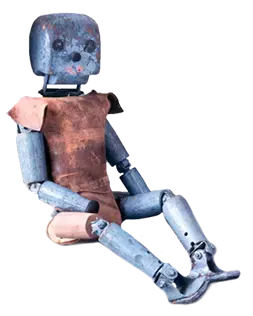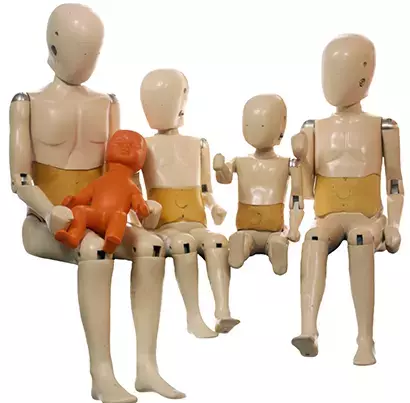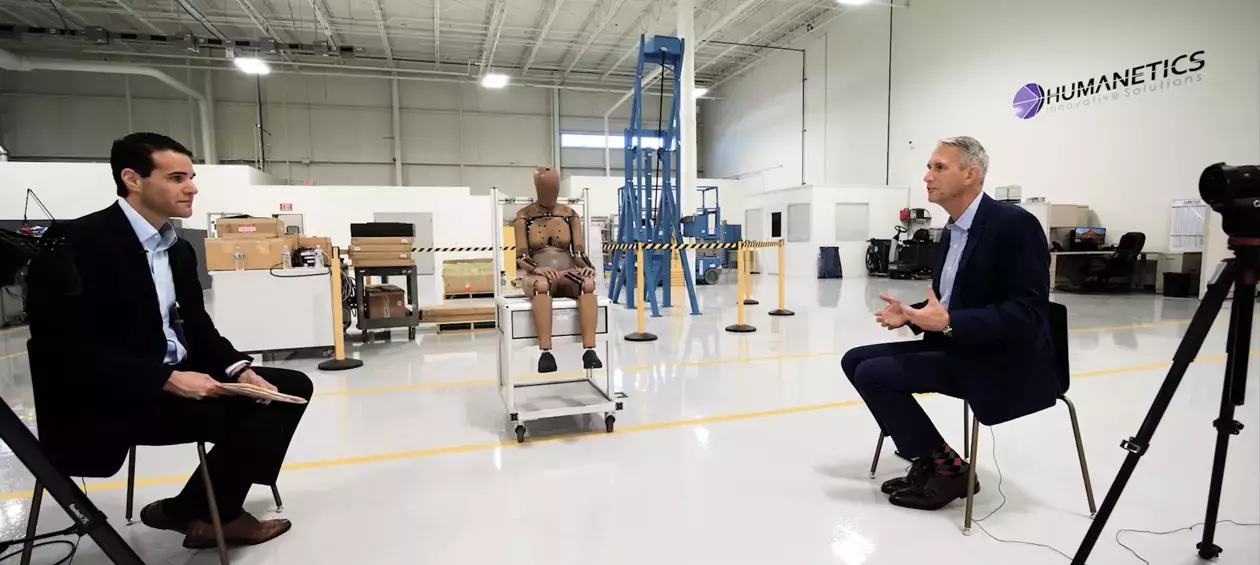Mind Your Ps & Qs: Europe’s Child Dummy Contributions to Automotive Occupant Safety
Child crash test dummies have evolved over the years to enhance the safety of our most precious automotive cargo.
The First Automotive Safety Testing for Children
As recently as the 1950s, the automotive industry paid little attention to occupant safety even in the face of rising injury and fatality rates on the ever-expanding roadway infrastructures around the globe. Including the most basic passive safety crash countermeasure, the tried-and-true seat belt, meant implying your car model wasn’t safely designed and thus discouraged critical buyers. But in 1966, Ralph Nader’s influential book Unsafe at Any Speed became a best-seller, and the U.S. Congress passed the National Traffic and Motor Vehicle Safety Act, which would lead to creation of the National Highway Traffic Safety Agency, or NHTSA, in 1970. These events and others around the globe demanded the development of crash test dummies that could faithfully replicate human anatomical response to the full range of potential crash forces.
The first automotive crash test dummies were of adult size, mimicking the low, mid, and high end of this population’s anthropometric scale. But it wasn’t long after these first adult dummies were introduced came the realization that children weren’t being adequately protected from injury in auto accidents. The industry needed a new set of test dummies and testing protocols to assess the dangers encountered by the youngest of human automotive occupants. The first challenge in child safety was to correct the misbelief that children can be held on their parent’s lap while riding in an automobile and be kept safe during an accident. Addressed in 1973 by TNO (Netherlands Organization for Applied Scientific Research) the Pinocchio dummy prototype was created. Basically, just a puppet made of wood to represent a child, Pinocchio was meant to simulate a child’s mass and physical occupation of space within the vehicle and little more.

The industry would soon move to correct the imbalance between adult and child testing and produce more complex and varying sizes of children.
Here come the Ps
In 1979 and 1980, TNO presented the P-Series of child dummies (deriving the name from that first Pinocchio dummy). Developed with support from the United Nations child expert group, the Ps benefitted from the Pinocchio and finally filled the gap in the dummy market. TNO organized the Child Anthropometry Database (CANDAT) and collected data from different regions of the world (U.S., Europe, Japan) to assess and subsequently improve the anthropometry of child dummies.This was a historic innovation in automotive safety assessment to finally have dummies representing a newborn, 9-month-old, 3-year-old, 6-year-old and 10-year-old child.

Later, in 1994, to complete the series, the P1.5 dummy representing an 18-month-old child was introduced. This dummy represented a step in the right direction, bridging the design gap between the P-Series and the eventual next generation Q-Series. The P1.5 contained only a few metal parts, unlike the rest of the family, utilizing a plastic skeleton, a lumbar spine made of a circular rubber column with a steel cable, and body parts made from plastics and polymers. With the P-Series being the first of its kind, the United Nations Economic Commission for Europe (ECE or UNECE) adopted the dummies into its Regulation Number 44 for the assessment of child restraint systems. However, with the series’ limited biofidelity and limited injury assessment capabilities, child occupant safety assessment would soon outgrow the constraints of the Ps.
Next Up in the Child Alphabet: The Qs
In 1996, the development of the Q dummy series began with funding from Europe’s Child Restraint Standards (CREST) and Child Injury Led Design (CHILD) projects and concluded with the Q10 in 2008 using shared funding from the Enabling Protection for Older Children (EPOCh) endeavor.
Consequently, in parallel to the activities in Europe, the Society of Automotive Engineers (SAE) Biomechanics Committee and the NHTSA developed child Anthropomorphic Test Devices (ATDs) for the Hybrid-III family of crash test dummies beginning in 1992. Hybrid-III child dummies representing a 3-year-old, 6-year-old and 10-year-old were defined in the Code of Federal Regulations (CFR) 49 Part 572 and then adopted for use in Federal Motor Vehicle Safety Standards (FMVSS) 208 and 213.

The first Q dummy, the Q3, was developed in 1996 with up-to-date anthropometry, additional instrumentation, and enhanced certification possibilities (compared to P-Series dummies). The Q1, Q3 and Q6 were then developed, used, and improved from 1999 to 2003 during the CREST program with the goal to optimize the dummy designs, propose injury criteria, and develop test procedures. The Q0 6-week-old newborn was later developed under the CHILD program from 2002 to 2006.
The overarching Q dummy features an omnidirectional design (optimized for frontal impact), accurate and realistic simulation of anatomy, anatomical representation of the ribcage, shoulder, and pelvis, and realistic mass distribution. New materials were exploited; mainly plastics instead of metals. The dummies were easy to use with minimal adjustment, and performance was based on biomechanical data. The Qs were designed ready for side impact testing (in position testing), airbag testing, and research purposes (like out-of-position assessments). With their more science-based design, the Q dummies have undoubtably improved seat design and child protection since first being introduced.
Evolution is Good
“If evolution really works, how come mothers only have two hands?” – Milton Berle
But seriously, everything can improve and evolve, and it’s no different for crash test dummies. Some ATDs can take decades to reach a point of acceptable performance. And even then, their ongoing path to ‘perfection’ can still be a continuous winding road.
As part of the CHILD program, the Q dummies continued to evolve and improve their durability while retaining anthropometry and biofidelity. As evaluation by the European Enhanced Vehicle Safety Committee (EEVC) Working Groups continued for introduction into ECE R44, the Q1.5 was produced to add coverage for all ECE R44 mass groups in its child restraint system assessments.
Overall design improvements continued with new head and neck designs and new durable rubber shoulder components. In the Q3 and Q6, the Infra-Red Telescoping Rod for the Assessment of Chest Compression (IR-TRACCs) replaced the string potentiometers and modified hip cups and elbow joints were incorporated.

Part of the EPOCh program saw the production and refinement of the Q10, a 10.5-year-old which represents the upper range of child restraint use, demanding that children up to 1.5 meters in height must be restrained. The design features two-dimensional (2D) IR-TRACCs for upper and lower ribs, a new laterally compliant pelvis based on the adult WorldSID dummy, and a shoulder design with human-like clavicles.
Since the original design of the Q6 and Q10 did not provide for measuring loads in the area of the Anterior Superior Iliac Spine (ASIS) and provided no assessment of abdominal loads or submarining, ASIS load cells were developed to solve this issue. Furthermore, as an alternative to the ASIS load cells, Abdominal Pressure Twin Sensors (APTS) were developed by IFSTTAR, consisting of a soft cylindrical bladder filled with oil and using a subminiature pressure sensor in the cap.
Meanwhile, across the pond, the NHTSA began adapting the Q3 into a side impact dummy intended to complement the Hybrid III 3-year-old ATD used in FMVSS testing. The Q3s was developed in cooperation with the NHTSA, the Occupant Safety Research Partnership (OSRP) and others. The goal was to modify the Q3 dummy with a new side impact neck, shoulder, ribcage and pelvis as well as new upper arm and leg flesh to focus purely on lateral biofidelity. The NHTSA released a Q3s Notice of Proposed Rulemaking (NPRM) in 2014, and the Final Rule for inclusion into CFR Part 572 in October of 2020.
And lastly, in 2017 the European New Car Assessment Programme (Euro NCAP) proposed modifying the Q10 to improve performance and shoulder belt stability for Euro NCAP protocols. As a result, the Euro NCAP Child Working Group issued a set of new Q10 design requirements and announced in 2018 that these final updates will be applied in the Euro NCAP 2020 test protocols.
Notably, all the Q dummies have since been painstakingly modeled in multiple FE codes, including LS-DYNA, Pam-Crash, Radioss, and Abaqus for use in sophisticated computer simulations, providing the best analysis approach in all crash situations.
Q Dummies All Over the World
The Q-series was first utilized in UNECE R44 and then its successor R129 for frontal and rear impact testing in the assessment of child restraint systems. Euro NCAP soon initiated them into their testing protocols for rear seat occupants in the frontal impact with the Mobile Progressive Deformable Barrier (MPDB) as well as for the side impact with the Advanced European Mobile Deformable Barrier (AE-MDB).
Today, almost all global regulatory and consumer rating bodies use the Q-Series of child dummies in their testing routines and assessment protocols. This is a fitting tribute to the advancement of child safety in all parts of the globe and a reminder that children are the most important cargo in any vehicle traveling on our roads.

Mark Brown
Mark is the Product Marketing Manager at Humanetics Safety and works closely with Engineering and Sales to develop and refine content that is both useful and informative for our industry. With over two decades of experience in crash test dummy product Quality, Technical, Sales, and Marketing, Mark produces a wide range of media and publications including our service bulletins, webinars, editorial articles, and contributes to our marketing collateral.
